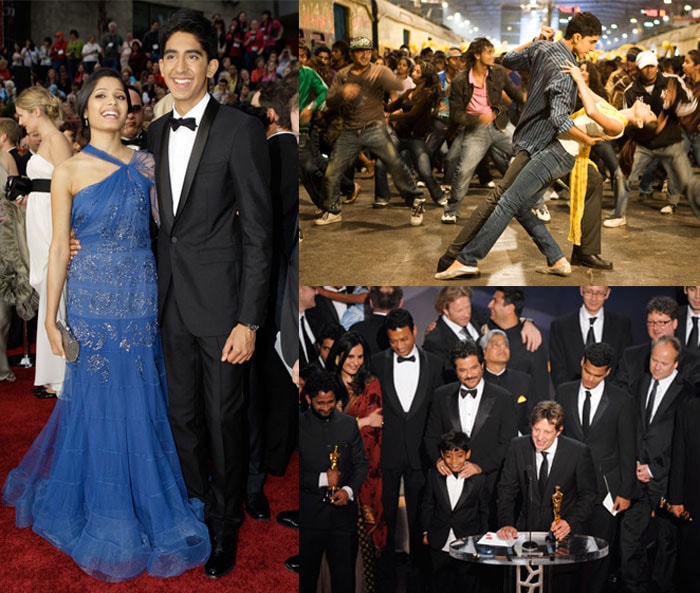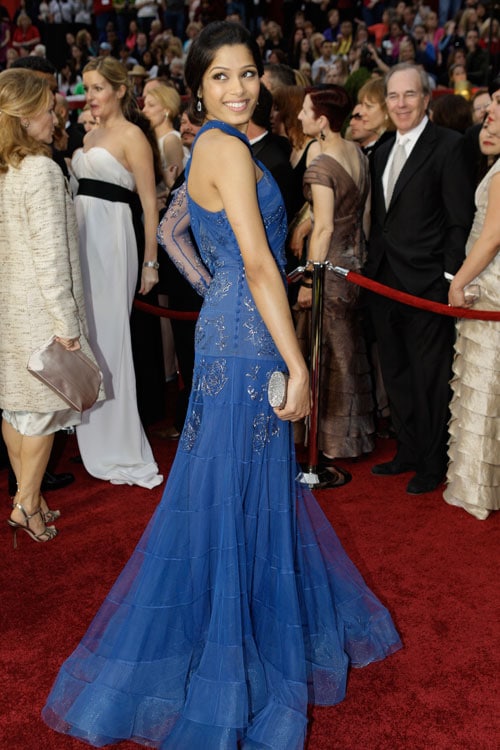India's Oscar Story
India had an Oscar moment like never before with Slumdog Millionaire's 2009 award sweep.
-
 In 2014, Liar's Dice, the double National Film Award- winning film by director Geethu Mohandas, was chosen as India's official entry for the Oscars Foreign language film category.
In 2014, Liar's Dice, the double National Film Award- winning film by director Geethu Mohandas, was chosen as India's official entry for the Oscars Foreign language film category.
The Hindi film, featuring Nawazuddin Siddiqui and Geetanjali Thapa in the lead roles, was based on the journey of a woman and her daughter in search of her missing husband.
Coming up: India's Oscar story, the films that were, the films that weren't and the films that could have been. -
 In 1957, Mehboob Khan's rural story of motherhood and hardship went to the Oscars. Mother India became the very first Indian movie to make the final five in the Best Foreign Film category. It lost to The Nights of Cabiria.
In 1957, Mehboob Khan's rural story of motherhood and hardship went to the Oscars. Mother India became the very first Indian movie to make the final five in the Best Foreign Film category. It lost to The Nights of Cabiria. -
 3 decades lapsed before there was Indian film on the Academy list again. In 1988, Mira Nair's Salaam Bombay! made the cut. It lost to Pelle The Conqueror but proved that there was more to Indian cinema than the manufactured sentiment peddled by ‘80s mainstream Bollywood.
3 decades lapsed before there was Indian film on the Academy list again. In 1988, Mira Nair's Salaam Bombay! made the cut. It lost to Pelle The Conqueror but proved that there was more to Indian cinema than the manufactured sentiment peddled by ‘80s mainstream Bollywood. -
 In 2001, Aamir Khan and pre-Independence era underdog film, Lagaan, was India's great hope at the Kodak Theatre. Keeping Lagaan company in the final five was French film Amelie but the Oscar went to the Bosnian No Man's Land.
In 2001, Aamir Khan and pre-Independence era underdog film, Lagaan, was India's great hope at the Kodak Theatre. Keeping Lagaan company in the final five was French film Amelie but the Oscar went to the Bosnian No Man's Land. -
 2009's Slumdog Millionaire was how the West was finally won. Made by a British director and crew, the film brought India to Hollywood in an extraordinary story of survival in the underbelly of Mumbai. Slumdog was an Indian invasion into the ranks of the Academy, with an award haul that included Best Film.
2009's Slumdog Millionaire was how the West was finally won. Made by a British director and crew, the film brought India to Hollywood in an extraordinary story of survival in the underbelly of Mumbai. Slumdog was an Indian invasion into the ranks of the Academy, with an award haul that included Best Film. -
 Among the slew of awards for Slumdog Milliionaire were A R Rahman's two trophies for Best Original Score and Best Original Song. The music of Bollywood went global and the world found an anthem in Jai Ho.
Among the slew of awards for Slumdog Milliionaire were A R Rahman's two trophies for Best Original Score and Best Original Song. The music of Bollywood went global and the world found an anthem in Jai Ho. -
 There was more to come – little known Resul Pookutty shared the Sound Mixing prize with Richard Pryke and Ian Tapp. The Slumdog juggernaut was unstoppable.
There was more to come – little known Resul Pookutty shared the Sound Mixing prize with Richard Pryke and Ian Tapp. The Slumdog juggernaut was unstoppable. -
 India put its best face forward in the delicately lovely Freida Pinto who quickly capitalized on the Slumdog effect by achieving It Girl status in a series of dramatic dresses.
India put its best face forward in the delicately lovely Freida Pinto who quickly capitalized on the Slumdog effect by achieving It Girl status in a series of dramatic dresses. -
 But even Freida's newly minted fashion stardom could not dim the appeal of the real Slumdog stars at the Oscars. Tanay, Rubina, Tanvi, Ashutosh, Azharuddin and Ayush were red carpet darlings, endearing themselves to the world at large.
But even Freida's newly minted fashion stardom could not dim the appeal of the real Slumdog stars at the Oscars. Tanay, Rubina, Tanvi, Ashutosh, Azharuddin and Ayush were red carpet darlings, endearing themselves to the world at large. -
 Even as Slumdog's Latika made her way into Hollywood hearts, another little Indian girl quietly brought home more Oscar glory as Smile Pinki won Best Short Documentary.
Even as Slumdog's Latika made her way into Hollywood hearts, another little Indian girl quietly brought home more Oscar glory as Smile Pinki won Best Short Documentary. -
 But Rahman's dream run at the Oscars wasn't the first taste India had of individual award scores. In 1983, costume designer Bhanu Athaiya became the first Indian to take home a Golden Man. She shared the Best Costume Design with John Mollo for their work in Richard Attenborough's Gandhi.
But Rahman's dream run at the Oscars wasn't the first taste India had of individual award scores. In 1983, costume designer Bhanu Athaiya became the first Indian to take home a Golden Man. She shared the Best Costume Design with John Mollo for their work in Richard Attenborough's Gandhi. -
 Gandhi, made by an all British crew, won 8 Oscars that year. British-Indian actor Ben Kingsley won the acting prize for his authentic portrayal of the Mahatma.
Gandhi, made by an all British crew, won 8 Oscars that year. British-Indian actor Ben Kingsley won the acting prize for his authentic portrayal of the Mahatma. -
 The next year, there was another British film about India at the Oscars. David Lean directed the film adaptation of E M Forster's A Passage To India, which won 2 out of the 11 Oscars it was nominated for. Among it's cast were Indian actors Victor Banerjee, Saeed Jaffrey and Roshan Seth.
The next year, there was another British film about India at the Oscars. David Lean directed the film adaptation of E M Forster's A Passage To India, which won 2 out of the 11 Oscars it was nominated for. Among it's cast were Indian actors Victor Banerjee, Saeed Jaffrey and Roshan Seth. -
 In 1992, Bengali filmmaking legend Satyajit Ray was presented the Lifetime Oscar by his favourite actress, Audrey Hepburn. Ray joined an elite corps of film luminaries including Akira Kurosawa, Orson Welles and Laurence Olivier, proving that Indian cinema was greater than the sum of its Bollywood fare.
In 1992, Bengali filmmaking legend Satyajit Ray was presented the Lifetime Oscar by his favourite actress, Audrey Hepburn. Ray joined an elite corps of film luminaries including Akira Kurosawa, Orson Welles and Laurence Olivier, proving that Indian cinema was greater than the sum of its Bollywood fare. -
 But Ray, Rahman and Athaiya aside, India's Oscar story has been one of heartbreak. In 1958, Madhumati was the official entry in the Best Foreign Language category. Starring Dilip Kumar and Vyjanthimala, Bimal Roy's tale of reincarnation and revenge failed to strike a chord with the Academy. Madhumati did not make the final five.
But Ray, Rahman and Athaiya aside, India's Oscar story has been one of heartbreak. In 1958, Madhumati was the official entry in the Best Foreign Language category. Starring Dilip Kumar and Vyjanthimala, Bimal Roy's tale of reincarnation and revenge failed to strike a chord with the Academy. Madhumati did not make the final five. -
 Satyajit Ray's The World of Apu took the film festival circuit by storm. India's great hope at the Oscars in 1959, Ray's black and white depiction of the life of boy from the villages of Bengal was left in the cold by the Academy.
Satyajit Ray's The World of Apu took the film festival circuit by storm. India's great hope at the Oscars in 1959, Ray's black and white depiction of the life of boy from the villages of Bengal was left in the cold by the Academy. -
 A year later, in 1960, the Academy similarly passed over Mughal-e-Azam, K Asif's epic love story starring Dilip Kumar and Madhubala.
A year later, in 1960, the Academy similarly passed over Mughal-e-Azam, K Asif's epic love story starring Dilip Kumar and Madhubala. -
 Not even Tragedy Queen Meena Kumari's emotional quotient could help conquer Mount Oscar. 1963's Sahib Bibi Aur Ghulam was buried in nominationless oblivion.
Not even Tragedy Queen Meena Kumari's emotional quotient could help conquer Mount Oscar. 1963's Sahib Bibi Aur Ghulam was buried in nominationless oblivion. -
 Adapted from R K Narayan's acclaimed novel, Guide brought Bollywood glory in 1965 to actors Dev Anand and Waheeda Rehman, but not Hollywood recognition.
Adapted from R K Narayan's acclaimed novel, Guide brought Bollywood glory in 1965 to actors Dev Anand and Waheeda Rehman, but not Hollywood recognition. -
 In 1974, M S Sathyu's Garam Hawa pioneered the new wave of art house cinema in Bollywood. Did it make the Oscar cut? The answer is a resounding no.
In 1974, M S Sathyu's Garam Hawa pioneered the new wave of art house cinema in Bollywood. Did it make the Oscar cut? The answer is a resounding no. -
 Shyam Benegal's Manthan, starring Smita Patil, won a slew of awards at home, including two National Awards. Among India's strongest Oscar contenders, Manthan's luck with the Academy in 1976 proved no better than that of the films earlier.
Shyam Benegal's Manthan, starring Smita Patil, won a slew of awards at home, including two National Awards. Among India's strongest Oscar contenders, Manthan's luck with the Academy in 1976 proved no better than that of the films earlier. -
 In 1978, a second Satyajit Ray film was submitted by India. Led by Sanjeev Kumar, India's brightest art house cinema talents could not take Shatranj Ke Khiladi, or The Chess Players, into the Oscar lists.
In 1978, a second Satyajit Ray film was submitted by India. Led by Sanjeev Kumar, India's brightest art house cinema talents could not take Shatranj Ke Khiladi, or The Chess Players, into the Oscar lists. -
 The Khans led charge of the next generation of Oscar hopefuls. Shah Rukh Khan tried and failed with Devdas in 2002 and Paheli in 2005.
The Khans led charge of the next generation of Oscar hopefuls. Shah Rukh Khan tried and failed with Devdas in 2002 and Paheli in 2005. -
 Aamir Khan, who missed the Oscar by the skin of his teeth with Lagaan, has been India's favourite ambassador to the Academy – with no success. Rang De Basanti, Taare Zameen Par and 2010's Peepli Live all missed the final five mark.
Aamir Khan, who missed the Oscar by the skin of his teeth with Lagaan, has been India's favourite ambassador to the Academy – with no success. Rang De Basanti, Taare Zameen Par and 2010's Peepli Live all missed the final five mark. -
 In 2011, A R Rahman went to the Oscars again. Nominated twice for Danny Boyle's 127 Hours, Rahman was unable to repeat his Slumdog The music maker, who previously sang Jai Ho at the Oscar ceremony in 2009, performed his song If I Rise at show.
In 2011, A R Rahman went to the Oscars again. Nominated twice for Danny Boyle's 127 Hours, Rahman was unable to repeat his Slumdog The music maker, who previously sang Jai Ho at the Oscar ceremony in 2009, performed his song If I Rise at show.
Advertisement
Advertisement
Advertisement
Advertisement